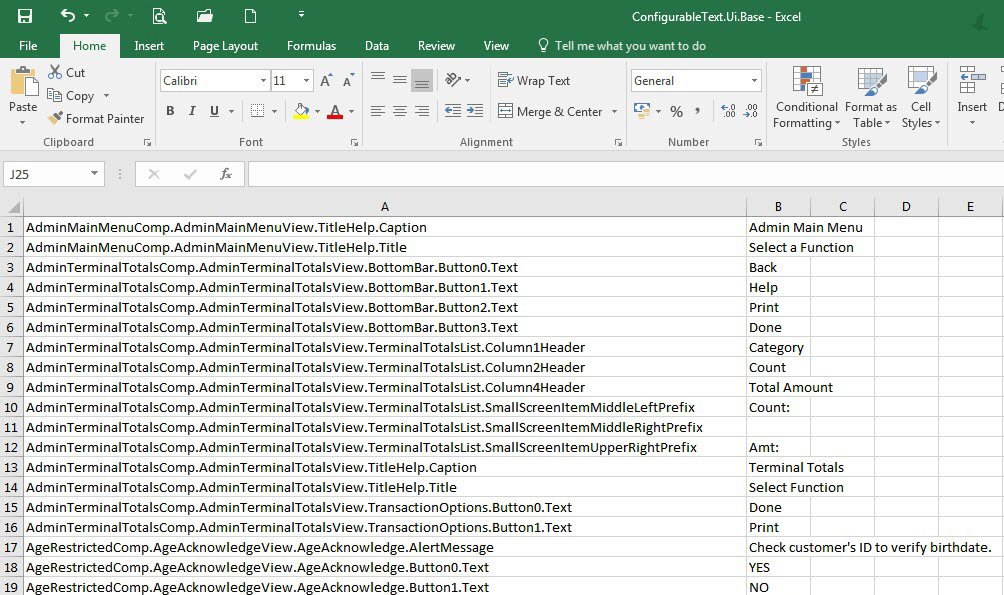Renaming POS UI Elements and Receipt Text
Retailers can customize the POS user interface (UI) text and receipt text by changing values in configurable text files. The following section describes the concepts necessary to understand and modify the configurable text files. The terms "Configurable Text Files" and "Configurable Text Tool" can be used interchangeably.
Configurable Text File concepts
Advanced Store uses two sets of comma-separated files to configure user interface text. These files can be edited in a standard text editor or spreadsheet application, such as Microsoft Excel.
The configurable text files must be saved in a comma-separated value (.csv) file format; otherwise, the system will not recognize the files, and the POS UI will have missing text items.
Base software configurable text files
There are two default English-language configurable text files located on the POS terminal, each in a different folder.
| File name | Folder |
|---|---|
| ConfigurableText.Ui.Base.csv | ConfigurableText folder: %PROGRAMFILES(X86)%\NCR\AdvancedStore\POS\ConfigurableText |
| ConfigurableText.Base.csv | BaseStrings folder: %PROGRAMDATA%\NCR\AdvancedStore\POS\Install\BaseStrings |
Retailers in the United States will use these base default-language files as the source for creating retailer-specific configurable text files. There are also base configurable text files for several languages and/or geographic regions. Use the language-specific file that corresponds to the store location or the user-interface language preference.
The ConfigurableText folder contains the following set of configurable text files:
- ConfigurableText.Ui.Base.csv (default language)
- ConfigurableText.Ui.Base.en-ca.csv
- ConfigurableText.Ui.Base.en-gb.csv
- ConfigurableText.Ui.Base.fi.csv
- ConfigurableText.Ui.Base.fr-ca.csv
- ConfigurableText.Ui.Base.ja.csv
- ConfigurableText.Ui.Base.no.csv
- ConfigurableText.Ui.Base.sv.csv
- ConfigurableText.Ui.Base.zh-chs.csv
The BaseStrings folder contains the following set of configurable text files:
- ConfigurableText.Base.csv (default language)
- ConfigurableText.Base.en-CA.csv
- ConfigurableText.Base.en-GB.csv
- ConfigurableText.Base.fi.csv
- ConfigurableText.Base.fr-CA.csv
- ConfigurableText.Base.ja.csv
- ConfigurableText.Base.no.csv
- ConfigurableText.Base.sv.csv
The base default-language and language-specific configurable text files must not be modified. If modified, these files will be overwritten during the next installation of the POS application.
Configurable text file contents
The contents of both the ConfigurableText.Ui.Base.csv file and the ConfigurableText.Base.csv file follow the same format.
The columns do not have headers or column titles. For the full list and descriptions of the configurable text file contents, consult with an NCR Voyix representative.
The following image displays sample rows from the ConfigurableText.Ui.Base.csv file.

| Column | Description |
|---|---|
| A (Lookup Key) | Specifies a UI element in the POS application. The lookup keys in column "A" follow a naming convention that identify the POS UI element, such as a screen, button, or text. Note
The values in this column must not be changed |
| B (Default Text Value) | Specifies the default text on the screens, buttons, and so on, that are displayed on the POS UI. The values in column "B" will be modified in the retailer-specific file to customize the POS UI text. |
| C and following (Optional) | Columns "C" and beyond provide additional columns for the retailer to use for notes, comments, and so on. These columns are not used by the POS application, and can be edited as needed in the retailer-specific copy of the file. |
Retailer-specific configurable text file
Because there are two sets of base configurable text files, the retailer will first identify the configurable text file that needs to be modified.
- ConfigurableText.UI.Base<language-region code>.csv files—contain some POS UI elements, such as screen text and help text.
- ConfigurableText.Base<language-region code>.csv files—contain more POS UI elements, such as information messages and buttons, as well as receipt text.
For help locating items in these files, consult with an NCR Voyix representative.
After locating the correct base default-language or language-specific configurable text file, the retailer will make a copy of the file, saving it to the ConfigurableText folder, and substituting the word "Base" for the word "RetailerX" in the file name. Alternatively, they can create an empty .csv file and name it accordingly. Specific instructions are provided in the next topic, Changing the names of UI components and receipt text.
A retailer opens both of the base default-language configurable text files and discovers that the UI text they want to customize is located in the ConfigurableText.Base.csv file, which resides in the BaseStrings folder.
- A retailer with stores in the US will create a copy of the default-language text file, ConfigurableText.Ui.Base.csv file and rename it ConfigurableText.Ui.RetailerX.csv.
- A retailer using the Canadian French language will create a copy of the corresponding language-specific text file, ConfigurableText.Base.fr-ca.csv, rename it ConfigurableText.RetailerX.fr-ca.csv.
The retailer then moves the newly-created RetailerX file from the BaseStrings folder into the ConfigurableText folder.
The customized RetailerX text file does not need to have all of the POS UI text lookup keys and values that are included in the base file. To make updates and maintenance easier, NCR Voyix recommends that the customized RetailerX text file contain only the text entries that must be customized.
When the POS application is started, it searches for the text files that it will use from the ConfigurableText directory. It applies data from the first file where it finds the UI element to be displayed, using the following priority order:
- The RetailerX language-specific .csv files. For example, ConfigurableText.Ui.RetailerX.fr-ca.csv and ConfigurableText.RetailerX.fr-ca.csv.
- The RetailerX default-language .csv files, ConfigurableText.Ui.RetailerX.csv and ConfigurableText.RetailerX.csv.
- The base language-specific .csv files. For example, ConfigurableText.Ui.Base.fr-ca.csv and ConfigurableText.Ui.Base.fr-ca.csv.
- The base default-language .csv files, ConfigurableText.Ui.Base.csv and ConfigurableText.Base.csv.
Modified POS UI text is applicable only to the POS terminal where the changes are made.
